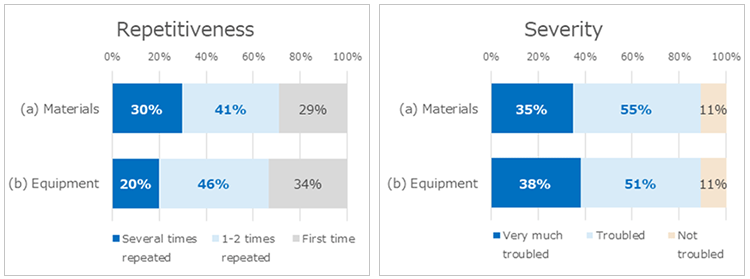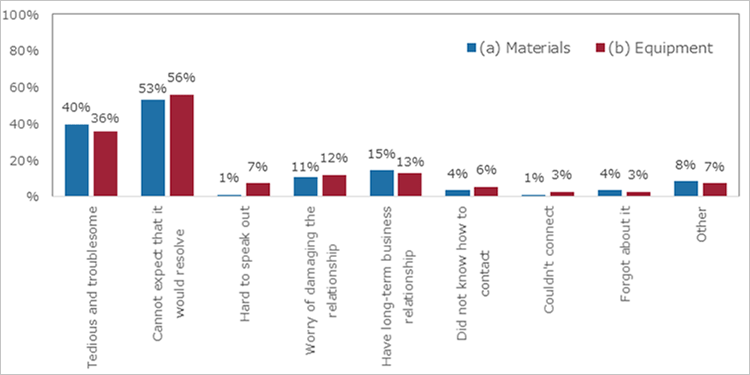BtoB Marketing Updated (2) Only Half of the Customer’s Complaints Surface
In the previous article (https://www.nikkei-r.co.jp/english/column/8776) , we uncovered the “pain points” (dissatisfaction or disappointment experienced upon purchase or product use/service) along the customer journey of customers of certain BtoB companies and found that those occur in unexpected areas.
In this article, we will discuss how many customers experienced those pain points at such BtoB business scenes and how they reacted. We will again focus on two typical BtoB products — (a) Materials: materials, raw materials, and electronic components and (b) Equipment: production process equipment including industrial equipment, measuring and weighing equipment, machine tools, and control equipment. We hope you find our insights useful in deepening your understanding of customers.
85% of customers experienced pain points, and 90% of them are “troubled”
Figure1 shows the percentage of respondents who experienced any pain point in the past year during the selection, implementation, or use of products and services.

Both, the “Materials” and the “Equipment” showed that 85% of customers had experienced some form of a pain point. This is 20 points higher than the 65% for BtoC (consumers who have experienced a pain point over the past year). In most cases in BtoB, it was revealed that customers continue business with the supplier despite inconveniences and disappointments. Around 70% of those who experienced a pain point stated that they had repeatedly experienced the same pain point, and about 90% of the respondents were “troubled,” alongside their business relationship with the supplier (Figure 2).

Over half are “silent customers”. No complaints do not mean a good relationship
So, how do customers react when they experience a pain point?
Figure 3 shows how many customers have taken certain actions — whether they have contacted the suppliers for resolving the problems or filed complaints or expressed their dissatisfaction.

The share of respondents who made inquiries or complaints was 56% in the “Materials” and 52% in “Equipment.” Although the rate is higher compared to BtoC at 28%, still, nearly half of the customers remain silent even after experiencing a pain point.
We can see that there are many “silent customers” who do not feedback on their dissatisfaction or disappointment with the company, and therefore “hidden dissatisfactions” lie unknown to the companies. Companies should not feel happy if they receive “no complaints.” That is not equal to a “good relationship with few complaints.” In reality, the actual status of businesses is not circled back to the company.
The top reason for customers not informing the company was “cannot expect resolve or improvement after feedback” at over 50%, indicating that they are somewhat giving up on the companies (Figure 4).

Customers also seem to be conscious of not interfering with long-term, continuous business relationships with the companies and hesitate to raise minor problems.
On the other hand, many BtoB companies have established their market position through a strong sales force as well as high technology advantages and might be overconfident and conceit in collecting enough customer complaints and requests through their excellent sales representatives engaging daily through various communication channels; visiting, phone, email, etc.
90% are unsatisfied with the response to their complaints
An even more shocking result is the level of satisfaction in response to the inquiry (complaint) (Figure 5).

Customers who were satisfied (“Very much satisfied” + “Satisfied”) with suppliers’ responses to their inquiries sum up to only 11% for "Materials" and 13% for “Equipment.” In other words, we can say that 90% have been betrayed by their suppliers.
As a result of repeatedly experiencing disappointing responses after inquiries, half of the respondents feel they “cannot expect resolve or improvement,” making it the top reason for not giving feedback, and that turns into a cycle that worsens over time.
No matter the unsatisfactory, business partnerships continue... (But not forever)
Why do business partnerships continue with these frustrated customers?
As indicated in the reasons for not giving feedback, BtoB business is often based on an ongoing business relationship where the provider and buyer are connected at their core business operation level, and cannot easily break.
In BtoB, the products and services bought are not simply consumed but are important pieces that add value to the company's products. It is thought of to better maintain a stable ongoing relationship rather than surfacing minor pain points, in one aspect partly due to the Japanese business customs.
While, in a mature market, it is becoming increasingly difficult for Japanese BtoB companies to differentiate themselves with their core strength; the quality of their products and services. It might be good to get a bird's-eye view of what kind of products and values of experiences are being provided to customers, and check upon the company on how they are dealing with their customers — anything missing from the customer's needs or reconsider something necessary that was given up in the past, etc.
To be recognized for the value of your technology and products, you must change the way you deal with customers; how you provide information or handle sales and marketing.
Without that change, you may lose customers against your competitors.
| Survey Outline (BtoB CX Survey) | |
|---|---|
| Timing | May 25 (Wed) - June 8 (Wed), 2022 |
| Target audience | Employed by a company (exclude public sectors) Involved in the selection/purchase/use/receiving supports from suppliers as a client-side |
| Focused products |
|
| Number of respondents | 2,532 |
| Methodology | Online survey, recruited from the Nikkei ID research service, fulfilling the above conditions |
| Survey Outline (Consumer CX Survey) | |
|---|---|
| Timing | February 2020 |
| Target audience | Age 16 and above, Japan nationwide |
| Number of respondents | 12,368 |
| Methodology | Online survey, respondents recruited through Nikkei Research’s proprietary panel |
-
Dec/07/2022
please contact us below.

